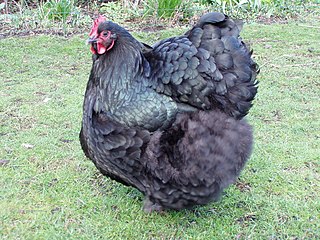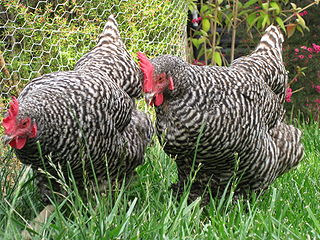
The American Game is an American breed of game fowl, chickens bred specifically for cockfighting. It has many color varieties, and may also be kept for ornament.

The Leghorn, Italian: Livorno or Livornese, is a breed of chicken originating in Tuscany, in central Italy. Birds were first exported to North America in 1828 from the Tuscan port city of Livorno, on the western coast of Italy. They were initially called "Italians", but by 1865 the breed was known as "Leghorn", the traditional anglicisation of "Livorno". The breed was introduced to Britain from the United States in 1870. White Leghorns are commonly used as layer chickens in many countries of the world. Other Leghorn varieties are less common.

The Orpington is a British breed of chicken. It was bred in the late nineteenth century by William Cook of Orpington, Kent, in south-east England. It was intended to be a dual-purpose breed, to be reared both for eggs and for meat, but soon became exclusively a show bird.

The Cochin is a breed of large domestic chicken. It derives from large feather-legged chickens brought from China to Europe and North America in the 1840s and 1850s. It is reared principally for exhibition. It was formerly known as Cochin-China.

The Plymouth Rock is an American breed of domestic chicken. It was first seen in Massachusetts in the nineteenth century, and for much of the early twentieth century was the most widely kept chicken breed in the United States. It is a dual-purpose chicken, raised both for its meat and for its brown eggs. It is resistant to cold, easy to manage, and a good sitter.

The Japanese Bantam or Chabo is a Japanese breed of ornamental chicken. It is a true bantam breed, meaning that it has no large fowl counterpart. It characterised by very short legs and a large upright tail that reaches much higher than the head of the bird.

The New Hampshire Red or New Hampshire is an American breed of chicken. It was developed in the early twentieth century in the state of New Hampshire by selective breeding of Rhode Island Red stock; no other breed was involved. It is fast-growing, early-maturing, quick-feathering, and yields a meaty carcass. Mature birds are a light or medium red in color; they may fade in sunlight.

The Barbu d'Uccle or Belgian d'Uccle, Dutch: Ukkelse Baardkriel, is a Belgian breed of bearded bantam chicken. It was first bred in the town of Uccle on the outskirts of Brussels, in central Belgium, in the early years of the twentieth century. It is a true bantam, with no standard-sized large fowl counterpart, and is one of eleven Belgian true bantam breeds.

The Sebright is a British breed of bantam chicken. It is a true bantam – a miniature bird with no corresponding large version – and is one of the oldest recorded British bantam breeds. It is named after Sir John Saunders Sebright, who created it as an ornamental breed by selective breeding in the early nineteenth century.
The Nankin Bantam or Nankin is a British bantam breed of chicken. It is a true bantam, a naturally small breed with no large counterpart from which it was miniaturised. It is of South-east Asian origin, and is among the oldest bantam breeds. It is a yellowish buff colour, and the name is thought to derive from the colour of nankeen cotton from China.

The Booted Bantam or Dutch Booted Bantam is a European breed of true bantam chicken. It is characterised by abundant feathering on the feet and shanks, which gives it a "booted" appearance; and by vulture hocks, long stiff downward-pointing feathers on backs of the thighs, from which the Dutch name Sabelpoot ("sabre-legged") derives.

The Java is a breed of chicken originating in the United States. Despite the breed's name, a reference to the island of Java, it was developed in the U.S. from chickens of unknown Asian extraction. It is one of the oldest American chickens, forming the basis for many other breeds, but is critically endangered today. Javas are large birds with a sturdy appearance. They are hardy, and are well-suited for both meat and egg production, especially by small-scale farms, homesteads, and backyard keepers.

The Scots Grey is a dual-purpose breed of domestic chicken originating in Scotland, where it has been bred for more than two hundred years. It was formerly known as the Scotch Grey and until about 1930 was popular in Scotland. It is on the "Native Poultry Breeds at Risk" list of the Rare Breeds Survival Trust.

The Silver Appleyard is a British breed of domestic duck. It was bred in the first half of the twentieth century by Reginald Appleyard, with the aim of creating a dual-purpose breed that would provide both a good quantity of meat and plenty of eggs.

The Bionda Piemontese is a traditional Italian dual-purpose breed of chicken. It originates in the Piedmont region of north-western Italy, from which it takes its name. It may also be called the Bionda di Cuneo, after the comune of Cuneo or the surrounding province; Bionda di Villanova, after the comune of Villanova d'Asti in the province of Asti; Rossa delle Crivelle, after a village near Buttigliera d'Asti; or Nostralina.
The Romagnola is a traditional dual-purpose breed of chicken from the Emilia-Romagna region of Italy. Formerly widespread in central Italy, it came close to extinction in the late 20th century. In early 2012 the population was recovering and the breed was awaiting official recognition by the Federazione Italiana Associazioni Avicole, the federation of Italian poultry associations.
The Mericanel della Brianza is a breed of small chicken or bantam from Lombardy, in northern Italy. It takes its name from the Brianza, an area to the north-east of Milan, and from mericanell, a Lombard diminutive of merican "American". In early 2012 it was the only officially recognised Italian bantam breed.

The Valdarno is a breed of black dual-purpose chicken from the lower part of the Valdarno, the valley of the Arno river, in Tuscany, central Italy. It became virtually extinct in the 20th century, but the population is recovering. It is a quite different breed from the Valdarnese, which originates in the upper Valdarno, and is white.

The Siciliana is an ancient breed of chicken from the Italian island of Sicily. It is notable for its unusual double or rose comb, for the early age at which birds reach maturity, and for the unusual shape of the eggs. The Sicilian Buttercup, bred in Australia, Great Britain and the North America, derives from it, but its long separation from the original stock has led to marked differences between the two.

The Frizzle is a breed of chicken with characteristic curled or frizzled plumage. While the frizzle gene can be seen in many breeds, such as the Pekin and Polish, the Frizzle is recognised as a distinct breed in a number of European countries and Australia. In the United States frizzled chickens are not considered a breed, and at shows are judged by the standards of the breed they belong to.

















